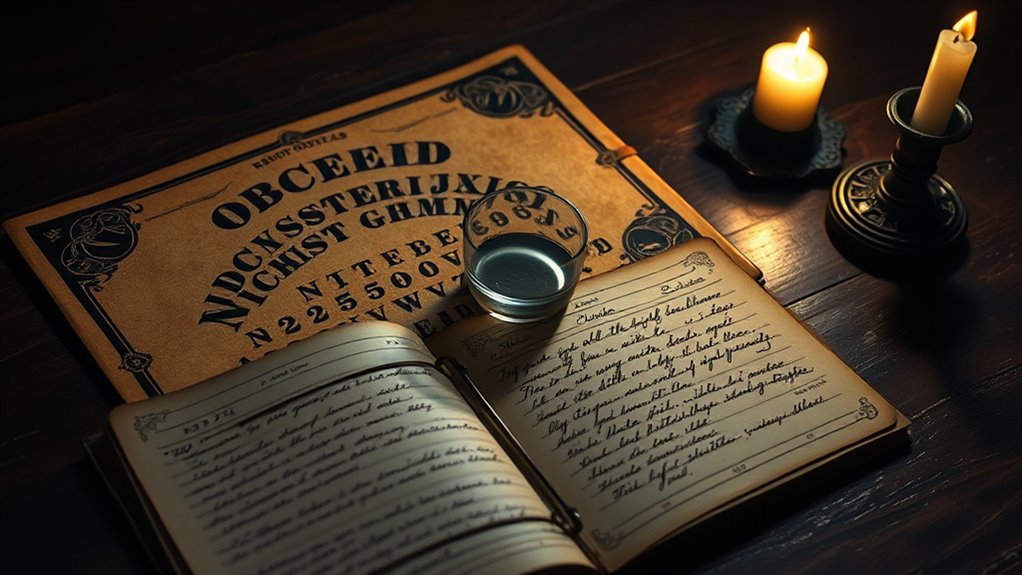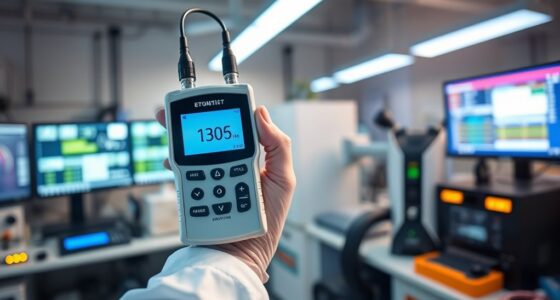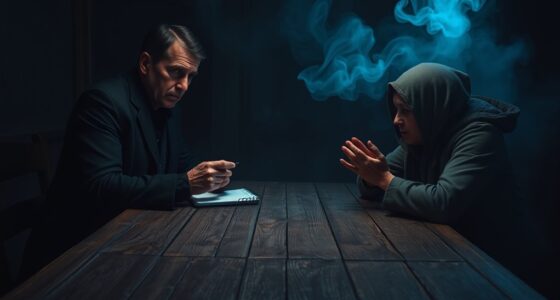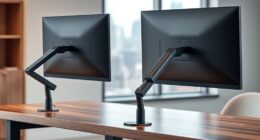If you want to communicate carefully with the other side through a Ouija board, it’s essential to approach with respect, clear intentions, and proper preparation. Create a calm environment, set protective boundaries, and stay grounded throughout the session. Focus on respectful communication and trust your intuition to interpret messages. Remember, maintaining emotional resilience and safety is key. If you keep exploring these practices, you’ll discover more ways to connect mindfully and safely.
Key Takeaways
- Set clear intentions, practice energy cleansing, and create a respectful, calm environment before beginning a session.
- Use gentle, focused contact with the planchette, paying attention to symbols and subtle movements for meaningful messages.
- Protect yourself with visualization, affirmations, and talismans to establish boundaries and ensure safe communication.
- Recognize signs of discomfort during the session and be prepared to pause or end if negative energies or distress appear.
- Post-session, journal experiences, practice grounding, and reinforce protective boundaries to process insights and maintain emotional safety.
Tracing the Origins of the Ouija Board
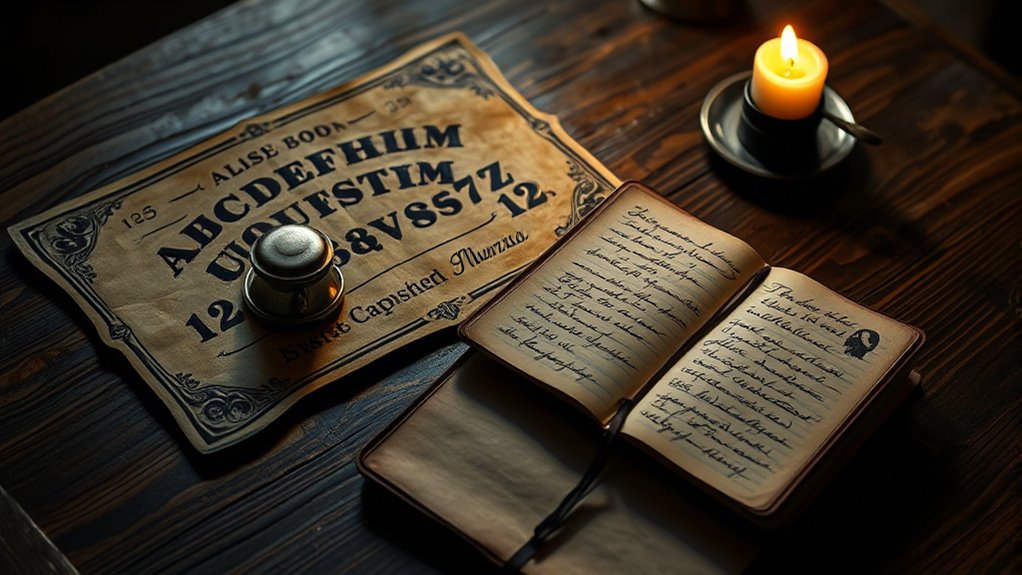
The origins of the Ouija board trace back to the late 19th century when spiritualism gained popularity in America. During this period, many believed the dead could communicate with the living, leading to a surge in spiritual symbolism in popular culture. Historical legends suggest that early versions of the board were used in séances to facilitate these connections. Inventors aimed to create a tool that could interpret messages from spirits, blending mystical symbols with simple mechanics. As the board became more widespread, it gained a reputation for being a mysterious conduit to the afterlife. This blend of spiritual symbolism and cultural fascination with spirits cemented its place in history, fueling both curiosity and superstition around its use. Additionally, the rise of Vetted – Doomsday Robots in modern times reflects an increasing interest in technological tools for survival and communication, which contrasts with the mystical origins of the Ouija board. The development of goal tracking methods in the 21st century also highlights how humans seek structured ways to understand and influence their environments, whether through technology or spiritual practices. Moreover, some scholars argue that the popularity of the Ouija board was also influenced by the broader cultural context of psychic phenomena and the desire to explore the unknown beyond conventional science. Some theories suggest that the popularity of the Ouija board also coincided with the rise of spiritualist movements, further embedding its role in the exploration of the supernatural.
Understanding How the Ouija Works
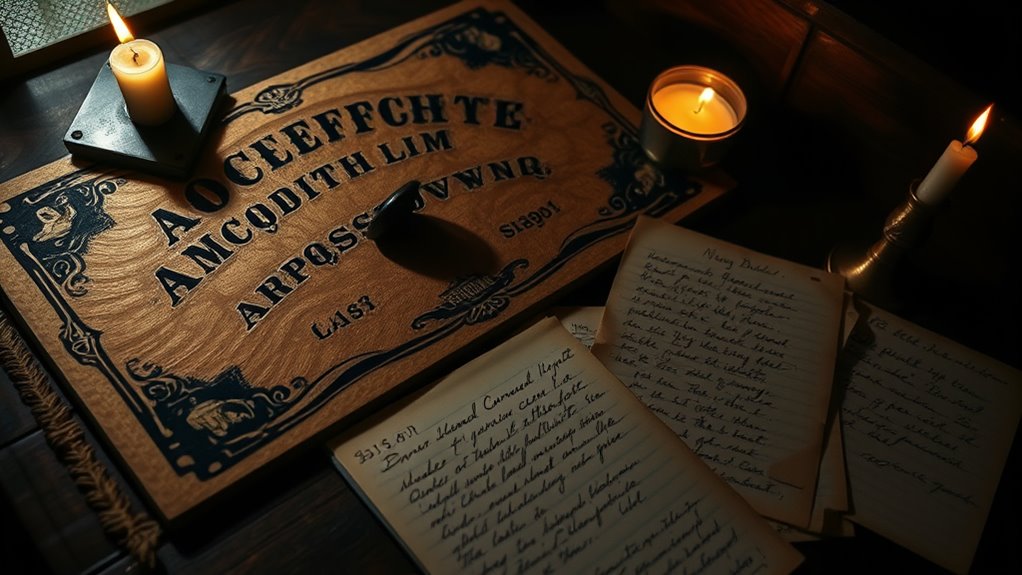
Understanding how the Ouija board operates can shed light on why it has fascinated so many people for generations. At its core, the board relies on spiritual symbolism, where symbols and words act as conduits for communication. When you place your hands on the planchette, you’re engaging in an energy transfer—your subconscious influences its movements, often without realizing it. Some believe that spiritual forces or spirits guide the planchette, translating energy into messages. Others see it as a psychological phenomenon, where your mind creates responses through ideomotor action. Regardless of perspective, the interaction hinges on the transfer of energy, making the process feel almost alive. This blend of symbolism and subconscious influence fuels the mystique surrounding the Ouija, encouraging curiosity and caution alike. Additionally, the size of a tiny house can influence its functionality and compliance with local regulations. Understanding the mechanisms behind the Ouija can also help demystify similar psychological phenomena, such as the ideomotor effect, that influence human perception and behavior. Moreover, awareness of energy transfer concepts can enhance our understanding of how subconscious and spiritual influences operate in various contexts.
Preparing Yourself for a Safe Session
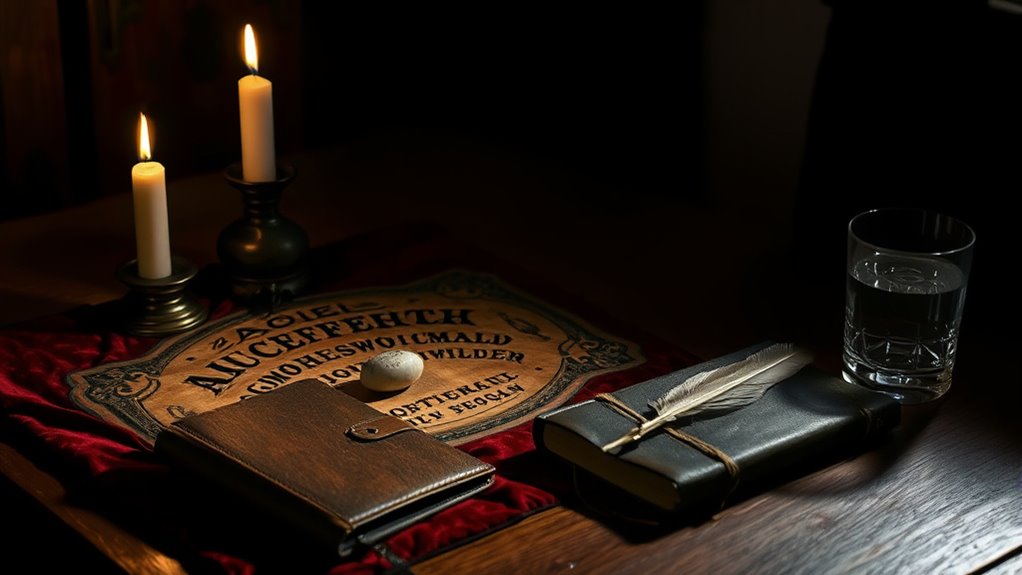
Before you begin a session with the Ouija board, it’s essential to prepare yourself mentally and emotionally. Start with energy cleansing to clear any negative or cluttered feelings that could interfere with your connection. Visualize a protective light surrounding you, establishing psychic protection against unwanted energies. Take deep breaths to center yourself and focus on your intention to communicate respectfully. Avoid distractions and stay grounded, ensuring your mind is calm and open. Remember, a clear and positive mindset helps create a safe environment for your session. By grounding yourself and setting a protective boundary, you reduce the risk of attracting negative influences. Incorporating mindfulness practices ensures that your communication remains secure and positive. Proper preparation helps guarantee your experience remains safe, respectful, and meaningful.
Choosing a Respectful and Suitable Environment
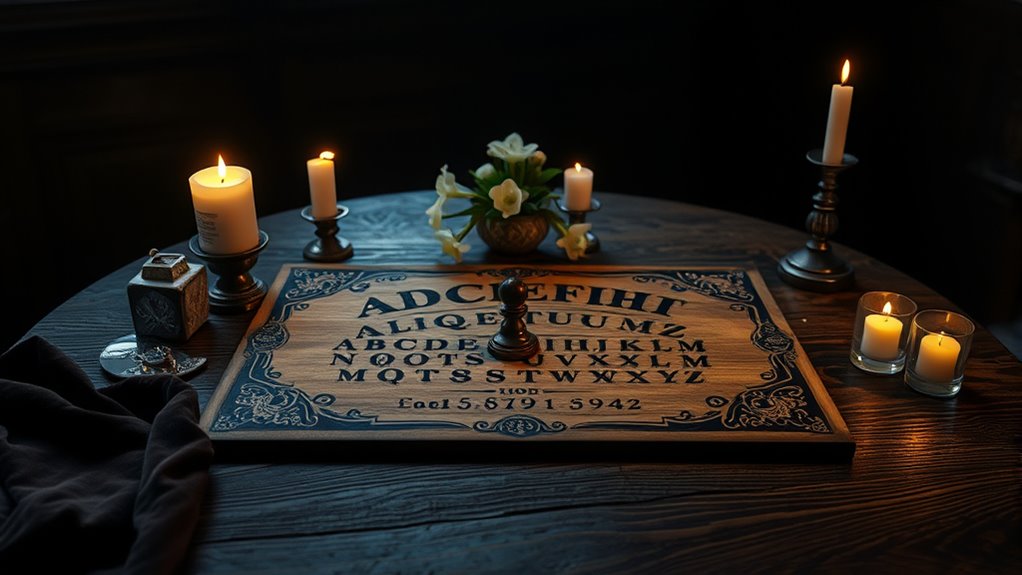
Choosing a respectful and suitable environment is essential for a safe and effective Ouija session. Your environment should promote focus and reverence, reflecting proper spiritual etiquette. Select a quiet, private space where interruptions are unlikely, and energies can settle. Avoid noisy or chaotic areas that can distract or create confusion. Lighting should be soft and calming, avoiding harsh or bright lights that might hinder concentration. Clear the space of clutter to foster a peaceful atmosphere. Remember, environment selection isn’t just about comfort—it’s about creating a respectful setting that invites genuine communication. Creating an environment with appropriate energy levels can enhance the likelihood of meaningful interaction. Ensuring the space is free from external distractions helps maintain focus and respect during your session. Additionally, cultivating a positive mindset can contribute to a more receptive and harmonious connection. Using drift prevention techniques, such as establishing clear intentions, can help maintain the integrity of the session. By choosing your environment carefully, you demonstrate respect for the spirits and set the tone for a meaningful, safe session.
Setting Clear Intentions and Boundaries
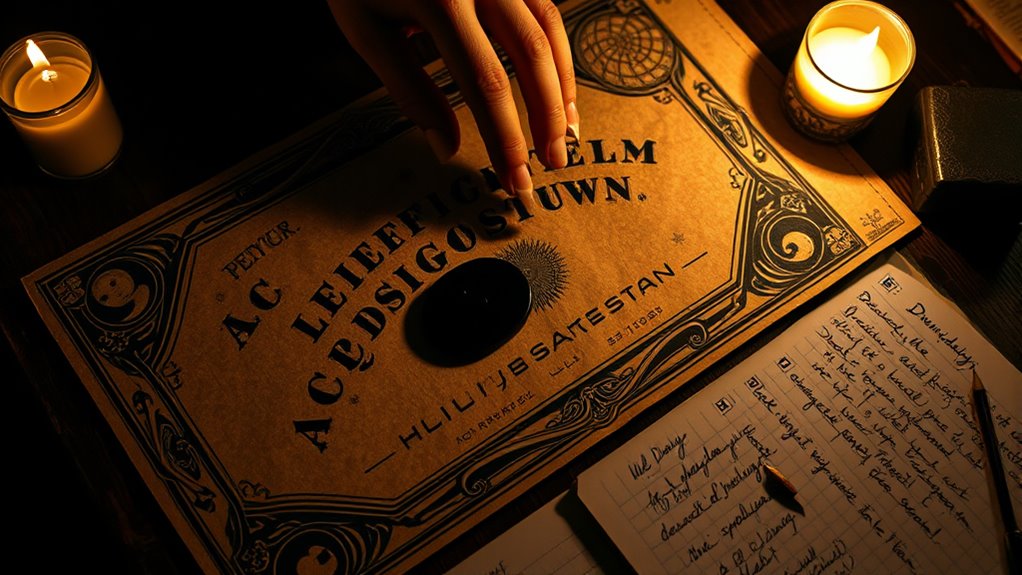
Once you’ve prepared a respectful environment, it’s important to clearly define what you hope to achieve during your session. Setting intentions helps guide your interactions and promotes mindful communication. Be specific about your goals—whether seeking answers, comfort, or understanding—and communicate these clearly. Equally important is establishing emotional boundaries; decide what topics you’re comfortable exploring and what is off-limits. This protects your well-being and keeps the session focused. Remember, setting boundaries isn’t about limiting the experience but about creating a safe space for respectful exchange. By being intentional and clear, you help ensure your session remains purposeful, respectful, and grounded in mindful communication. This clarity helps foster a balanced connection with the other side.
Proper Techniques for Conducting a Session
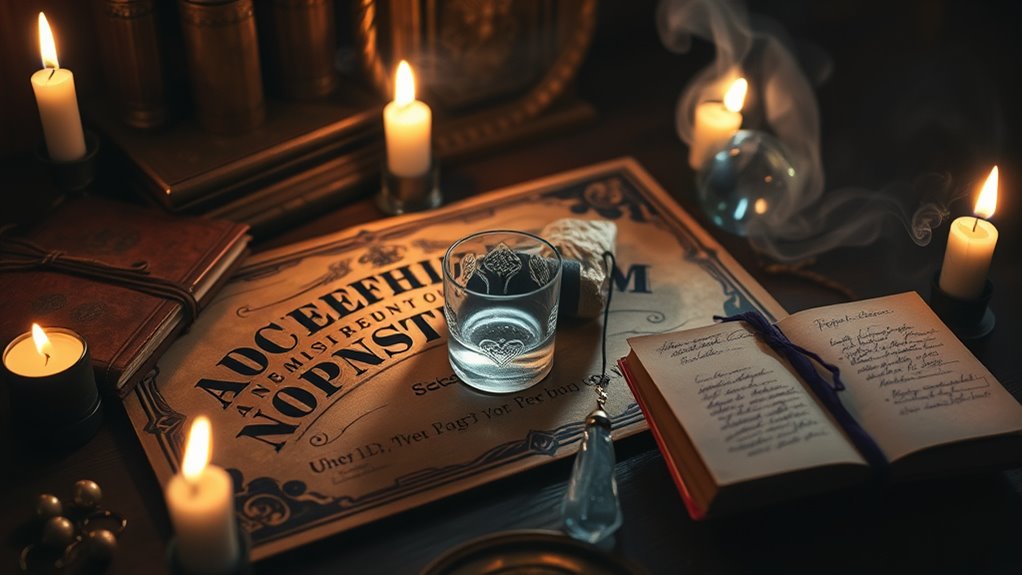
To conduct a session effectively, you need to follow specific techniques that promote clear communication and safety. Begin with spiritual grounding to center yourself and establish a stable mental state. This helps you stay focused and reduces the risk of negative influences. Before starting, perform energy cleansing around the board and your space to clear residual energies. Ensure your environment is calm, quiet, and free of distractions. Always use your clear intentions to guide the session and maintain respectful boundaries. Keep your hand lightly on the planchette, moving gently and intentionally. Avoid rushing or forcing responses. These techniques create a secure framework, helping you connect with the other side while protecting your energy and well-being.
Recognizing and Interpreting Messages

Recognizing and interpreting messages during a Ouija session requires your full attention and intuition. Pay close attention to the spiritual symbolism that emerges through the planchette’s movements, as these symbols often carry deeper meanings beyond words. Focus on the clarity of the messages; sometimes, the words may be vague or scrambled, so ask for clarification if needed. Trust your instincts to distinguish between genuine messages and random movements. Look for patterns, repeated symbols, or subtle shifts that indicate a clear message from the other side. Remember, the goal is to interpret with care and respect, always considering the context and your intuition. Clear, meaningful messages are your guide to meaningful communication with spirits.
Handling Unintended or Uncomfortable Encounters
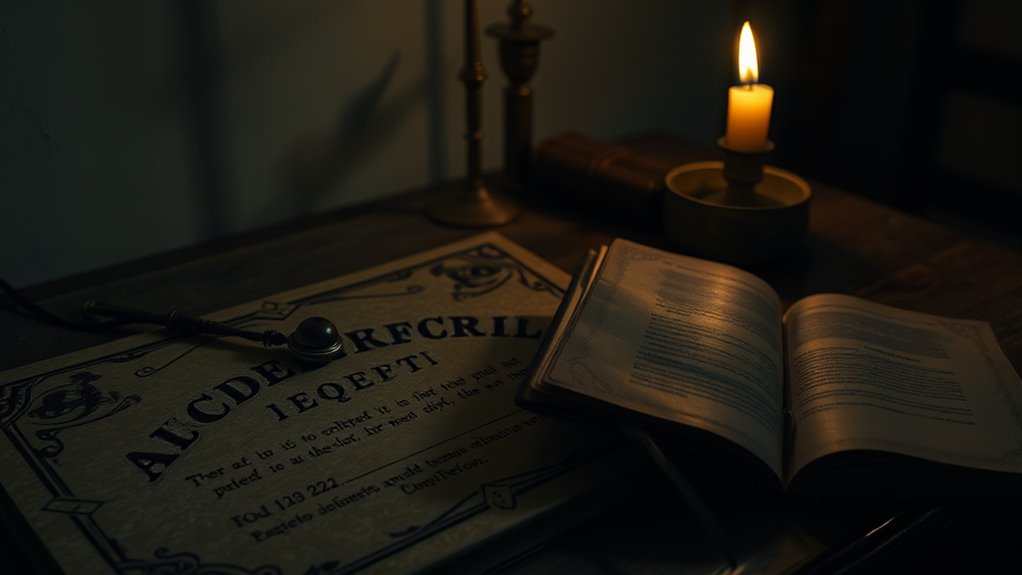
When you encounter distress signals during a session, it’s important to trust your instincts and recognize the signs. Setting clear protective boundaries can help you regain control and keep the experience safe. Remember, you have the power to pause or end the session whenever you feel uncomfortable.
Recognizing Distress Signals
Sometimes, during a séance with the Ouija board, you might notice subtle signs that things are going off course or becoming uncomfortable. These distress signals often show up as abrupt changes in energy awareness—sudden cold spots, a shift in the room’s atmosphere, or a feeling of unease. Pay close attention to your emotional resilience; if you start feeling overwhelmed, anxious, or drained, it’s a clear warning. Recognizing these signals early helps you slow down or pause the session before things escalate. Trust your instincts and be mindful of your emotional state. Staying alert to these cues allows you to handle unintended encounters carefully, ensuring your connection remains respectful and controlled.
Setting Protective Boundaries
If you notice unsettling signs during a séance, it’s important to establish clear protective boundaries to maintain control. You can do this by visualizing a shield of protective barriers around yourself, sealing off unwanted energies or spirits. Focus on strengthening your energetic boundaries, reaffirming that only positive or trusted entities are allowed to communicate. Speak aloud, “Only love and light may enter,” to reinforce your intention. Carry protective talismans or crystals, like black tourmaline or amethyst, to help ward off negative influences. Remember, setting these boundaries isn’t a one-time act—regularly reaffirm your protection before and during sessions. Clear boundaries empower you to control the experience, ensuring you remain grounded and safe throughout your communication.
Post-Session Care and Reflection
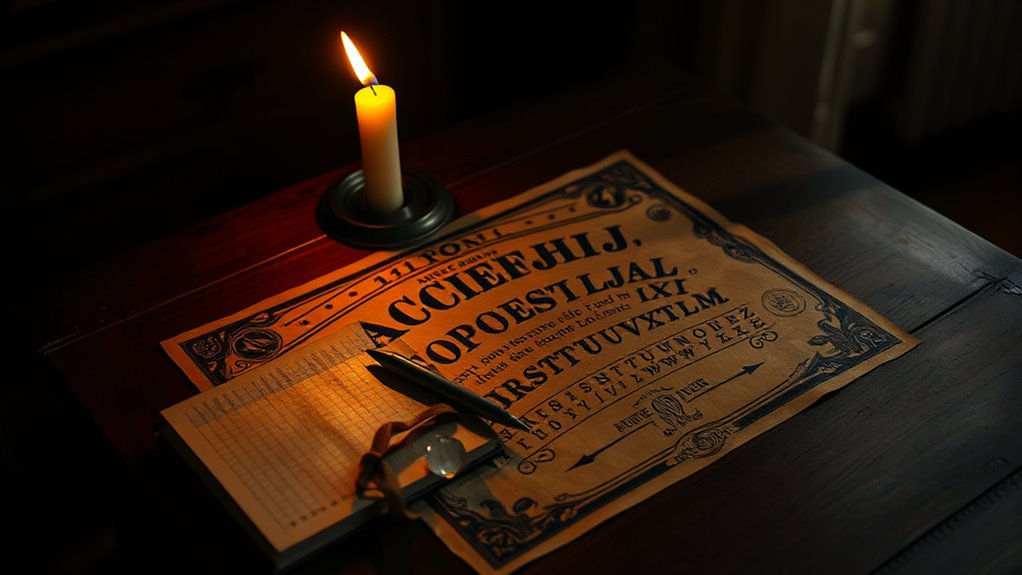
After your session, take a few moments to practice calming meditation to clear your mind and ground yourself. Consider journaling your experiences to process what occurred and identify any lingering emotions or insights. These simple steps help you reflect effectively and maintain your well-being after working with the Ouija board.
Post-Session Meditation Tips
Wondering how to best care for yourself after a Ouija board session? Start with mindful breathing to help ground your energy and calm your mind. Focus on slow, deep breaths, inhaling through your nose and exhaling through your mouth. This relaxes your nervous system and centers you. Next, perform energy clearing by visualizing a bright, protective light surrounding you, pushing away any residual negativity or lingering energies. Take a few moments to acknowledge the experience, then gently release any tension you’ve built up. Remember, your mental state influences your connection, so prioritize calming practices. By incorporating mindful breathing and energy clearing into your post-session routine, you create a safe space for reflection and re-establish your energetic boundaries.
Reflective Journaling Practices
Engaging in reflective journaling after a Ouija board session helps you process and understand your experience more clearly. Through meditative journaling, you create a safe space to explore your feelings and insights, fostering emotional processing. This practice allows you to connect with your subconscious and notice subtle messages from the session. As you write, you may uncover lingering fears, unexpected emotions, or profound realizations. To deepen this process, consider documenting your thoughts immediately after the session, capturing your raw emotional state. Reflective journaling can evoke feelings of relief, curiosity, or even vulnerability, helping you integrate the experience more mindfully. Remember, this is your personal journey—trust your intuition and be gentle with yourself during this emotional processing.
Frequently Asked Questions
Can Children Safely Use the Ouija Board?
You might wonder if children can safely use the Ouija board. For child safety, it’s best to follow age restrictions and consider their maturity level. Young children may not fully understand the implications, and the experience could be frightening or confusing. It’s advisable to supervise closely or avoid letting children use the board altogether. Prioritizing their emotional well-being and ensuring age-appropriate activities keeps them safe and secure.
What Should I Do if I Feel Overwhelmed During a Session?
If you feel overwhelmed during a session, take a deep breath and focus on grounding techniques like feeling your feet on the ground or holding a comforting object. Pause the session if needed, and don’t hesitate to seek professional help if your feelings persist or intensify. Remember, prioritizing your mental and emotional well-being is vital, so step back and take care of yourself before continuing.
Are There Any Spiritual Risks Associated With Using a Ouija Board?
Think of a Ouija board as a delicate gateway, where unseen currents flow between worlds. While it can be a tool for connection, you risk inviting negative energies that can disturb your spiritual balance. To protect yourself, use spiritual protection practices like grounding and shielding. Always approach with respect and caution, understanding that opening this door may attract unwanted influences if not handled carefully.
How Often Is It Safe to Conduct a Session?
You should limit your sessions to prevent any potential negative effects. Stick to a safe frequency limit, such as once a week or less, to avoid overexposure. Keep each session brief, ideally 15 to 20 minutes, to minimize risks. Regular breaks between sessions help maintain your emotional balance. Remember, listening to your intuition and stopping if you feel uneasy are key to safe communication.
Can the Ouija Board Be Used for Long-Term Communication?
Think of the Ouija board as a garden; long-term communication can invite weeds if you’re not careful. While some believe you can establish a spiritual boundary for ongoing chats, it’s wise to limit session frequency. Using it for extended periods risks opening doors you can’t easily close. To stay safe, consider short, intentional sessions and always end with a clear spiritual boundary.
Conclusion
As you gently close the door on your session, remember that the spirits are like whispers carried on the wind—delicate and fleeting. Treat each message with respect, like a fragile flower in your hand, and trust your instincts to navigate the unseen. With careful steps and an open heart, you’ll become a skilled traveler between worlds, guiding your journey with caution and curiosity, always respecting the mysterious dance of the spirits beyond.
